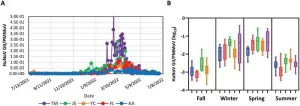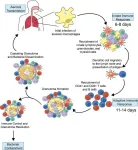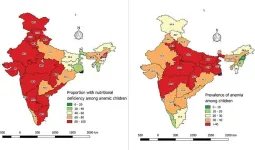(Press-News.org) Scientists have developed two agents, made of therapeutic nanoparticles and antibodies, that could be given to patients shortly before a blood draw to allow physicians to better detect tumor DNA in blood using a technology called liquid biopsy.
Liquid biopsies promise to transform how cancers are diagnosed, monitored, and treated by detecting DNA that tumors shed into the blood. But the body presents a significant challenge. Immune cells in the liver and DNA-degrading enzymes in blood remove circulating tumor DNA from the bloodstream within minutes, making this DNA difficult to capture and detect in a blood test.
To overcome this, a team from the Broad Institute of MIT and Harvard and Massachusetts Institute of Technology (MIT) have developed two injectable “priming agents” that briefly slow down the clearance of circulating tumor DNA from the body, allowing levels of this DNA to temporarily increase in blood and be collected for testing. The team says that these priming agents could improve the performance of liquid biopsies for cancer and potentially other diseases — akin to how contrast agents are given to patients to enhance medical imaging scans. Their findings are published in Science.
Viktor Adalsteinsson, director of the Gerstner Center for Cancer Diagnostics at Broad, Sangeeta Bhatia, an institute member at Broad, a professor at MIT and director of the Marble Center for Cancer Nanomedicine at MIT’s Koch Institute, and J. Christopher Love, an associate member at Broad and a professor at MIT’s Koch Institute, are co-senior authors of the study.
“Liquid biopsy stands to fundamentally change how cancer is diagnosed and treated but requires higher sensitivity,” said Adalsteinsson. “To improve sensitivity, we sought to address for the first time the biology of circulating tumor DNA clearance, recognizing this is a fundamental hurdle upstream of most liquid biopsy tests which, if solved, could broadly benefit patients.”
One of the priming agents consists of nanoparticles, which, like circulating tumor DNA, are consumed by immune cells in the liver. “We thought we could design a safe dummy nanoparticle to distract those immune cells and leave the circulating tumor DNA alone so that it could be at a higher concentration in blood samples,” Bhatia said.
The other agent comprises engineered antibodies that bind to tumor DNA, protecting them from destruction by circulating enzymes. Both strategies — therapeutic nanoparticles and antibodies — are already well-established forms of medicine for use in humans.
“Existing liquid biopsy technologies are limited by the amount of tumor DNA you have in the tube of blood,” Love said. “So we started to think about how we might inject something beforehand to help boost or enhance that signal.”
Carmen Martin-Alonso, a graduate student in Bhatia’s lab, spearheaded the design of the nanoparticles. Shervin Tabrizi, a postdoctoral associate in Love’s lab and the Gerstner Center at the Broad and a radiation oncologist at Massachusetts General Hospital, took the lead on engineering the antibodies. And Kan Xiong, a research scientist at the Gerstner Center at the Broad, led an effort to optimize the analysis of single droplets of mouse blood for circulating tumor DNA.
In mouse studies, the team showed that administering these priming agents one to two hours before drawing a blood sample each increased the amount of circulating tumor DNA in a blood sample by more than 10-fold. This improved the sensitivity of detecting cancer by liquid biopsy in mice with low tumor burden from below 10 percent to more than 75 percent. Circulating tumor DNA levels in the animals returned to baseline within a day.
“The ability to get peak activity of these agents within a couple of hours, followed by their rapid clearance, means that someone could go to their doctor's office, receive an agent like this, and then give their blood for the test itself, all within one visit,” Love said. “This feature bodes well for the potential to translate this concept into clinical use.”
The team says their priming agents represent new platform technologies that could in principle enhance liquid biopsies not only for cancer but also for neurodegenerative diseases, metabolic disorders, deep-seeded infectious diseases, and prenatal genetic testing, as well as for the detection of other scarce analytes of clinical significance.
“Boosting circulating tumor DNA in blood is just the tip of the iceberg,” Adalsteinsson said. “Priming is a new frontier we’re excited to further develop in cancer diagnostics and beyond.”
Funding:
This research was supported by Louis V. Gerstner, Jr., the Bridge Project (a partnership between the Koch Institute and the Dana-Farber/Harvard Cancer Center), the MIT Koch Institute’s Marble Center for Cancer Nanomedicine, the Cancer Center Support Grant from the National Cancer Institute, the Casey and Family Foundation Cancer Research, fellowship funding from “La Caixa”, The Ludwig Center Fellowship at Koch Institute, an ASCO Conquer Cancer Foundation Young Investigator, a Prostate Cancer Foundation Young Investigator Award, and the National Institutes of Health.
Paper cited:
Martin-Alonso C, Tabrizi S, Xiong K et al. Priming agents transiently reduce the clearance of cell-free DNA to improve liquid biopsies. Science. Online January 18, 2024. DOI: 10.1126/science.adf2341
About Broad Institute of MIT and Harvard
Broad Institute of MIT and Harvard was launched in 2004 to empower this generation of creative scientists to transform medicine. The Broad Institute seeks to describe the molecular components of life and their connections; discover the molecular basis of major human diseases; develop effective new approaches to diagnostics and therapeutics; and disseminate discoveries, tools, methods and data openly to the entire scientific community.
Founded by MIT, Harvard, Harvard-affiliated hospitals, and the visionary Los Angeles philanthropists Eli and Edythe L. Broad, the Broad Institute includes faculty, professional staff and students from throughout the MIT and Harvard biomedical research communities and beyond, with collaborations spanning over a hundred private and public institutions in more than 40 countries worldwide.
END
Injectable agents could improve liquid biopsy for cancer detection and monitoring
Researchers at Broad and MIT report the first injectable “priming agents” for liquid biopsy that increased circulating tumor DNA by more than 10-fold in mice
2024-01-18
ELSE PRESS RELEASES FROM THIS DATE:
A fungal pathogen, Rosellinia necatrix, that attacks plants, produces antimicrobials to combat the plant-hosted bacteria that would otherwise inhibit its infection success
2024-01-18
A fungal pathogen, Rosellinia necatrix, that attacks plants, produces antimicrobials to combat the plant-hosted bacteria that would otherwise inhibit its infection success.
####
Article Title: The soil-borne white root rot pathogen Rosellinia necatrix expresses antimicrobial proteins during host colonization
Article URL: http://journals.plos.org/plospathogens/article?id=10.1371/journal.ppat.1011866
Author Countries: Germany, Spain, the Netherlands
Funding: EACC and DET acknowledge receipt of PhD fellowships from CONACyT, Mexico. ALM is holder of a postdoctoral research fellow funded by the 'Fundación Ramón Areces'. BPHJT ...
Researchers improve blood tests’ ability to detect and monitor cancer
2024-01-18
CAMBRIDGE, MA -- Tumors constantly shed DNA from dying cells, which briefly circulates in the patient’s bloodstream before it is quickly broken down. Many companies have created blood tests that can pick out this tumor DNA, potentially helping doctors diagnose or monitor cancer or choose a treatment.
The amount of tumor DNA circulating at any given time, however, is extremely small, so it has been challenging to develop tests sensitive enough to pick up that tiny signal. A team of researchers from MIT and the Broad Institute of MIT and Harvard has now come up with a way to significantly boost that signal, by temporarily slowing the clearance of tumor DNA circulating in the bloodstream.
The ...
Sea otters may be key drivers of changes in California's kelp forests, according to data spanning a century
2024-01-18
Sea otters may be key drivers of changes in California's kelp forests, according to data spanning a century
#####
In your coverage please use this URL to provide access to the freely available article in PLOS Climate: https://journals.plos.org/climate/article?id=10.1371/journal.pclm.0000290
Article Title: Sea otter recovery buffers century-scale declines in California kelp forests
Citation: Nicholson TE, McClenachan L, Tanaka KR, Van Houtan KS (2024) Sea otter recovery buffers century-scale declines in California ...
Norovirus outbreaks are detectable by wastewater monitoring earlier than by other surveillance methods depending on reporting practices, making this a potentially important public health tool
2024-01-18
Norovirus outbreaks are detectable by wastewater monitoring earlier than by other surveillance methods depending on reporting practices, making this a potentially important public health tool.
####
Article URL: https://journals.plos.org/water/article?id=10.1371/journal.pwat.0000198
Article Title: Norovirus GII wastewater monitoring for epidemiological surveillance
Author Countries: USA
Funding: This study was supported by funding from the University of Michigan through the Public Health Infection ...
Climate change may reduce life expectancy by half a year, study suggests
2024-01-18
The cost of climate change may be six months off the average human lifespan, according to a study published January 18, 2024, in the open-access journal PLOS Climate by Amit Roy from Shahjalal University of Science and Technology and The New School for Social Research, U.S.
Temperature and rainfall — two telltale signals of climate change — cause myriad public health concerns, from the acute and direct (e.g., natural disasters like flooding and heat waves) to the indirect yet equally devastating (e.g., respiratory and mental illnesses). While impacts like these are observable and well documented, existing research has not established a direct link between climate change and life ...
Remodeling the immune system to fight tuberculosis
2024-01-18
AMHERST, Mass. – Tuberculosis, caused by the bacterium Mycobacterium tuberculosis (Mtb) kills upwards of 1.6 million people a year, making it one of the leading causes of death by an infectious agent worldwide—and that number is only growing larger. How, exactly, Mtb evades the immune system isn’t yet known, but a collaborative team of researchers from the University of Massachusetts Amherst and Seattle Children’s Research Institute recently discovered something surprising: prior exposure to a genus of bacteria called Mycobacterium seems to remodel the first-line defenders in the body’s immune system. Furthermore, how ...
6 in 10 sampled under-5s in India have micronutrient deficiencies, and 4 in 10 have anaemia, per survey of 17,230 children
2024-01-18
6 in 10 sampled under-5s in India have micronutrient deficiencies, and 4 in 10 have anaemia, per survey of 17,230 children.
####
Article URL: https://journals.plos.org/globalpublichealth/article?id=10.1371/journal.pgph.0002095
Article Title: Prevalence and determinants of anemia due to micronutrient deficiencies among children aged 12–59 months in India–Evidence from Comprehensive National Nutrition Survey, 2016–18
Author Countries: India
Funding: The authors received no specific funding for this work. END ...
DNA becomes our ‘hands’ to construct advanced nanoparticle materials
2024-01-18
Evanston, IL In a paper to be published in Science Jan. 18, scientists Chad Mirkin and Sharon Glotzer and their teams at Northwestern University and University of Michigan, respectively, present findings in nanotechnology that could impact the way advanced materials are made.
The paper describes a significant leap forward in assembling polyhedral nanoparticles. The researchers introduce and demonstrate the power of a novel synthetic strategy that expands possibilities in metamaterial design. These are the unusual materials that underpin “invisibility cloaks” and ultrahigh-speed optical computing systems.
"We manipulate ...
Repeated sexual failures cause social stress in fruit flies
2024-01-18
Repeated failures to reproduce make fruit flies stressed and frustrated, which in turn makes them less resilient to other types of stress, Julia Ryvkin at Bar-Ilan University and colleagues report in the open-access journal PLOS Genetics, publishing January 18.
Animals are motivated to take actions that improve their survival and reproduction through reward systems in the brain, but failure causes stress. The reward systems have been extensively studied, but less attention has been paid to how animals respond to failure. To investigate, researchers compared ...
Complement system causes cell damage in Long Covid
2024-01-18
Most people infected with the SARS-CoV-2 virus recover after the acute illness. However, a significant proportion of infected individuals develop long-lasting symptoms with a wide range of manifestations. The causes and disease mechanisms of Long Covid are still unknown, and there are no diagnostic tests or targeted treatments.
Part of the immune system active for too long
A team of researchers led by Onur Boyman, professor of immunology at the University of Zurich (UZH) and Director of the Department of Immunology at the University Hospital Zurich (USZ), has shown in a study that the complement system plays an important role in Long Covid. It is part of the innate immune system ...
LAST 30 PRESS RELEASES:
Colliding galaxies create the brightest, fastest growing black holes at their center
New BrainHealth research reveals tradeoffs on sleep with cannabis use for chronic pain
Aging-US now on ResearchGate, enhancing visibility for authors and readers
'Molecular glue' stabilizes protein that inhibits development of non-small cell lung cancer
Mount Sinai Health System is recognized in 2025 Chime Digital Health Most Wired survey
From prey to predator: How carnivores spread beneficial fungi
Menopause symptoms may be frequent and have negative effects, according to female endurance athletes
US Congressmembers’ responses on X to mass shooting events differ along party lines
KAIST-UEL team develops “origami” airless wheel to explore lunar caves
Individual genetic differences render some therapies ineffective
Engineering dendritic cells boosts cancer immunotherapy
Sophisticated neuroimaging reveals PTSD in WTC responders is linked to measurable physical changes in brain structure
Health policy experts identify promising strategies for providing health care to homeless people
Study explores role of neutrophils in canine atopic dermatitis
Mayo Clinic researchers develop AI-ECG model to diagnose liver disease earlier
Heavy menstruation common among teenage girls – questionnaire reveals risk of iron deficiency
New study explores why open water swimming feels so powerful for midlife women
In echo of Jurassic Park, mosquitoes capture entire ecosystems in their blood meals
Marty Cooper, Illinois Tech Alumnus and ‘Father of the Cell Phone,’ Receives 2025 Marconi Society Lifetime Achievement Award
How to reduce the risk of lymphedema
NEJM Evidence and CIDRAP announce Public Health Alerts
New fossil study illuminates on the evolutionary success of frogs
Patient-specific human liver model to understand disease mechanisms
Confused by the doctor's questionnaire? U of A study suggests it's common
How do brains stay stable, and when might a dose of flexibility be helpful?
mRNA revitalizes aging immune systems—the liver as a fountain of youth
Rural-urban differences in the prevalence of chronic pain among adult cancer survivors
Food insecurity, burnout, and social isolation among resident and fellow physicians
How do spinal cord injuries heal?
Detailed cell map unlocks secrets of how reproductive organs form
[Press-News.org] Injectable agents could improve liquid biopsy for cancer detection and monitoringResearchers at Broad and MIT report the first injectable “priming agents” for liquid biopsy that increased circulating tumor DNA by more than 10-fold in mice





